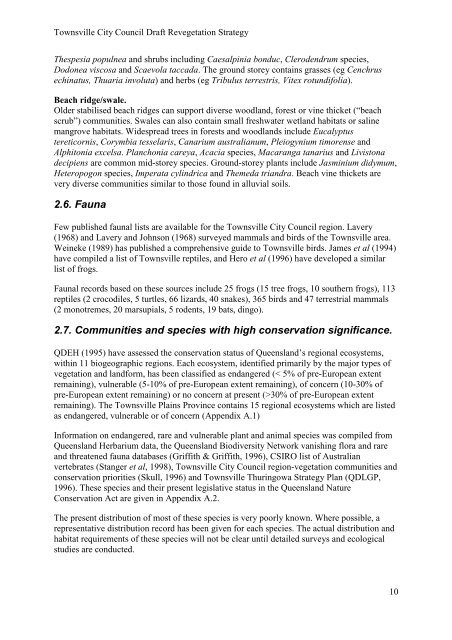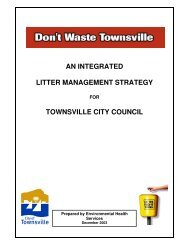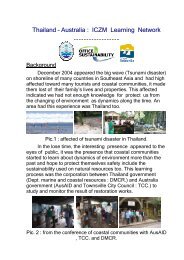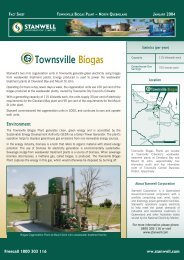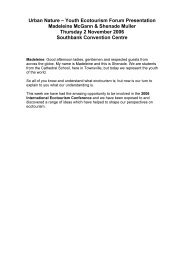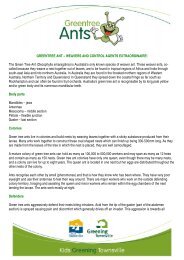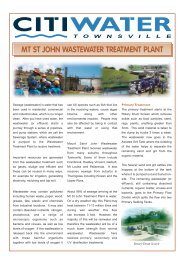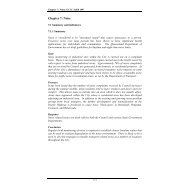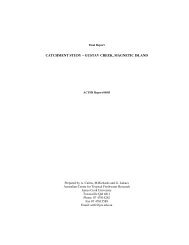Revegetation Strategy - Townsville State of the Environment Report
Revegetation Strategy - Townsville State of the Environment Report
Revegetation Strategy - Townsville State of the Environment Report
Create successful ePaper yourself
Turn your PDF publications into a flip-book with our unique Google optimized e-Paper software.
<strong>Townsville</strong> City Council Draft <strong>Revegetation</strong> <strong>Strategy</strong><br />
Thespesia populnea and shrubs including Caesalpinia bonduc, Clerodendrum species,<br />
Dodonea viscosa and Scaevola taccada. The ground storey contains grasses (eg Cenchrus<br />
echinatus, Thuaria involuta) and herbs (eg Tribulus terrestris, Vitex rotundifolia).<br />
Beach ridge/swale.<br />
Older stabilised beach ridges can support diverse woodland, forest or vine thicket (“beach<br />
scrub”) communities. Swales can also contain small freshwater wetland habitats or saline<br />
mangrove habitats. Widespread trees in forests and woodlands include Eucalyptus<br />
tereticornis, Corymbia tesselaris, Canarium australianum, Pleiogynium timorense and<br />
Alphitonia excelsa. Planchonia careya, Acacia species, Macaranga tanarius and Livistona<br />
decipiens are common mid-storey species. Ground-storey plants include Jasminium didymum,<br />
Heteropogon species, Imperata cylindrica and Themeda triandra. Beach vine thickets are<br />
very diverse communities similar to those found in alluvial soils.<br />
2.6. Fauna<br />
Few published faunal lists are available for <strong>the</strong> <strong>Townsville</strong> City Council region. Lavery<br />
(1968) and Lavery and Johnson (1968) surveyed mammals and birds <strong>of</strong> <strong>the</strong> <strong>Townsville</strong> area.<br />
Weineke (1989) has published a comprehensive guide to <strong>Townsville</strong> birds. James et al (1994)<br />
have compiled a list <strong>of</strong> <strong>Townsville</strong> reptiles, and Hero et al (1996) have developed a similar<br />
list <strong>of</strong> frogs.<br />
Faunal records based on <strong>the</strong>se sources include 25 frogs (15 tree frogs, 10 sou<strong>the</strong>rn frogs), 113<br />
reptiles (2 crocodiles, 5 turtles, 66 lizards, 40 snakes), 365 birds and 47 terrestrial mammals<br />
(2 monotremes, 20 marsupials, 5 rodents, 19 bats, dingo).<br />
2.7. Communities and species with high conservation significance.<br />
QDEH (1995) have assessed <strong>the</strong> conservation status <strong>of</strong> Queensland’s regional ecosystems,<br />
within 11 biogeographic regions. Each ecosystem, identified primarily by <strong>the</strong> major types <strong>of</strong><br />
vegetation and landform, has been classified as endangered (< 5% <strong>of</strong> pre-European extent<br />
remaining), vulnerable (5-10% <strong>of</strong> pre-European extent remaining), <strong>of</strong> concern (10-30% <strong>of</strong><br />
pre-European extent remaining) or no concern at present (>30% <strong>of</strong> pre-European extent<br />
remaining). The <strong>Townsville</strong> Plains Province contains 15 regional ecosystems which are listed<br />
as endangered, vulnerable or <strong>of</strong> concern (Appendix A.1)<br />
Information on endangered, rare and vulnerable plant and animal species was compiled from<br />
Queensland Herbarium data, <strong>the</strong> Queensland Biodiversity Network vanishing flora and rare<br />
and threatened fauna databases (Griffith & Griffith, 1996), CSIRO list <strong>of</strong> Australian<br />
vertebrates (Stanger et al, 1998), <strong>Townsville</strong> City Council region-vegetation communities and<br />
conservation priorities (Skull, 1996) and <strong>Townsville</strong> Thuringowa <strong>Strategy</strong> Plan (QDLGP,<br />
1996). These species and <strong>the</strong>ir present legislative status in <strong>the</strong> Queensland Nature<br />
Conservation Act are given in Appendix A.2.<br />
The present distribution <strong>of</strong> most <strong>of</strong> <strong>the</strong>se species is very poorly known. Where possible, a<br />
representative distribution record has been given for each species. The actual distribution and<br />
habitat requirements <strong>of</strong> <strong>the</strong>se species will not be clear until detailed surveys and ecological<br />
studies are conducted.<br />
10


